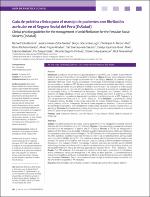Guía de práctica clínica para el manejo de pacientes con fibrilación auricular en el Seguro Social del Perú (EsSalud)

Related Resource(s)
https://revistasinvestigacion.unmsm.edu.pe/index.php/anales/article/view/16424Date
2019-06-30Author(s)
Soto Becerra, Richard
Zafra-Tanaka, Jessica Hanae
Goicochea-Lugo, Sergio
Alarcón-Ruiz, Christoper A.
Pacheco-Barrios, Kevin
Taype-Rondan, Alvaro
Guevara-Caicedo, Carolina
Espinoza-Rivas, Gladys
Cabrera-Saldaña, Mario
Zelaya-Castro, Pío
Zegarra-Carhuaz, Ricardo
Urday-Ipanaqué, Diana
Timaná-Ruiz, Raúl
Metadata
Show full item recordAlternate title
Clinical practice guideline for the management of atrial fibrillation for the Peruvian Social Security (EsSalud)
Abstract
Introducción. El presente artículo resume la guía de práctica clínica (GPC) para el manejo de pacientes con fibrilación auricular (FA) en el Seguro Social del Perú (EsSalud). Objetivo. Proveer recomendaciones clínicas basadas en evidencia para el manejo de pacientes con FA en EsSalud. Métodos. Se conformó un grupo elaborador (GEG) que incluyó médicos especialistas y metodólogos. El GEG formuló 9 preguntas clínicas a ser respondidas por la presente GPC. Se realizó búsquedas sistemáticas de revisiones sistemáticas y ,cuando fue considerado pertinente, estudios primarios en Medline durante el 2017. Se seleccionó la evidencia para responder cada una de las preguntas clínicas planteadas. La certeza de la evidencia fue evaluada usando la metodología Grading of Recommendations Assessment, Development, and Evaluation (GRADE). En reuniones de trabajo periódicas, el GEG usó la metodología GRADE para revisar la evidencia y formular las recomendaciones, los puntos de buenas prácticas clínicas y los flujogramas de la GPC. Finalmente, la GPC fue aprobada con Resolución N° 91 – IETSI – ESSALUD – 2018. Resultados. La presente GPC abordó 9 preguntas clínicas, divididas en tres temas: prevención de eventos tromboembólicos, estrategias de control y manejo de FA en emergencias. En base a dichas preguntas se formularon 12 recomendaciones (6 recomendaciones fuertes y 6 recomendaciones condicionales), 29 puntos de buena práctica clínica, y 2 algoritmos. Conclusión. El presente artículo resume la metodología y las conclusiones basadas en evidencias de la GPC para manejo de pacientes con FA en EsSalud. This article summarizes the clinical practice guide (CPG) for the management of patients with atrial fibrillation (AF) in the Social Security of Peru (EsSalud). Objective. To provide clinical recommendations based on evidence for the management of patients with AF in EsSalud. Methods. A CPG for the management of patients with AF in EsSalud was developed. To this end, a guideline development group (GDG) was established, including medical specialists and methodologists. The GDG formulated 9 clinical questions to be answered by this CPG. Systematic searches of systematic reviews and ,when it was considered pertinent, primary studies were conducted in Medline during 2017. The evidence to answer each of the posed clinical questions was selected. The quality of the evidence was evaluated using the Grading of Recommendations Assessment, Development, and Evaluation (GRADE) methodology. In periodic work meetings, the GDG used the GRADE methodology to review the evidence and formulate the recommendations, points of good clinical practice, and the flowchart of the CPG. Finally, the CPG was approved with Resolution No. 91 – IETSI – ESSALUD – 2018. Results. This CPG addressed 9 clinical questions, divided into three topics: prevention of thromboembolic events, maintenance therapy and management of AF. Based on these questions, 12 recommendations (6 strong recommendations and 6 weak recommendations), 29 points of good clinical practice, and 2 algorithms were formulated. Conclusion. This article summarizes the methodology and evidence-based conclusions from the CPG for the management of AF in EsSalud
Collections
- Artículos científicos [890]





